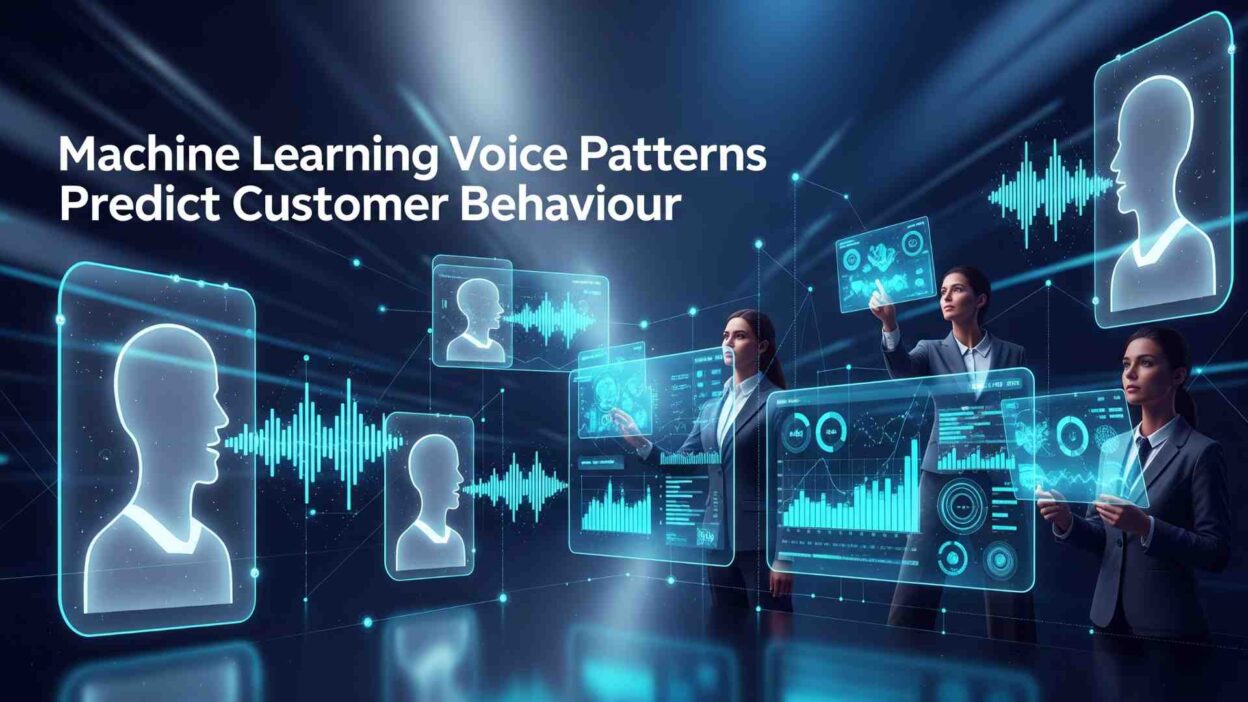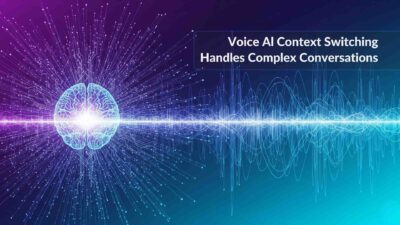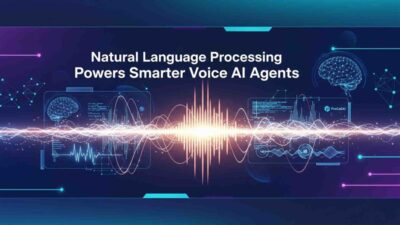TL;DR Machine learning voice patterns revolutionize how businesses understand customer intentions and emotions. Advanced algorithms analyze vocal characteristics to predict purchasing decisions and service needs. PreCallAI’s predictive calling AI technology harnesses these insights to create more effective customer interactions and drive superior business outcomes.
Table of Contents
Voice analysis has evolved beyond simple speech recognition to sophisticated behavioral prediction. Machine learning voice patterns enable businesses to anticipate customer needs before they express them directly. This breakthrough technology transforms ordinary phone conversations into valuable intelligence-gathering opportunities.
Machine Learning Voice Patterns and Predictive Intelligence
Machine learning voice patterns represent the intersection of artificial intelligence and human communication analysis. These systems examine vocal characteristics including tone, pitch, speed, and emotional indicators. Predictive calling AI platforms like PreCallAI use this data to forecast customer behavior with remarkable accuracy.
Traditional customer service relies on reactive responses to expressed customer needs. Machine learning voice patterns enable proactive service delivery based on predicted requirements and emotional states. This shift from reactive to predictive customer engagement creates significant competitive advantages.
What Are Machine Learning Voice Patterns?
Machine learning voice patterns are distinctive vocal characteristics that algorithms can identify and analyze systematically. These patterns include speech rhythm variations, emotional tone shifts, and linguistic choice preferences. Voice pattern recognition technology processes thousands of acoustic features simultaneously.
Predictive calling AI systems examine multiple voice dimensions to create comprehensive customer profiles. Vocal stress indicators reveal customer frustration levels before complaints emerge. Speech pace changes often predict purchase readiness or service urgency.
Machine learning algorithms identify subtle patterns that human listeners typically miss. Machine learning voice patterns analysis operates at speeds impossible for human processors. Real-time pattern recognition enables immediate response optimization during active conversations.
What Are Voice Patterns in Terms of Customer Data?
Voice patterns represent rich datasets containing emotional, psychological, and behavioral information. Machine learning voice patterns analysis extracts meaningful insights from seemingly casual conversations. Customer voice data includes conscious communication and unconscious vocal indicators.
Predictive calling AI systems categorize voice patterns into actionable business intelligence categories. Excitement patterns indicate sales opportunities requiring immediate attention. Confusion patterns suggest need for additional explanation or support resources.
Vocal patterns change throughout conversations as customer emotions and confidence levels shift. Machine learning voice patterns tracking monitors these changes to optimize conversation outcomes. Dynamic pattern recognition adapts responses to evolving customer states.
How Do Machine Learning Voice Patterns Work for Prediction?
Machine learning voice patterns analysis begins with comprehensive audio data collection and processing. Advanced algorithms segment conversations into analyzable components for pattern identification. Predictive calling AI systems process multiple audio streams simultaneously without performance degradation.
Voice pattern recognition requires sophisticated machine learning models trained on extensive datasets. These models learn to associate specific vocal characteristics with customer behaviors. Machine learning voice patterns accuracy improves continuously through exposure to diverse conversation examples.
Real-time pattern processing enables immediate customer behavior predictions during active conversations. Predictive calling AI platforms provide instant insights to human agents or automated systems. This immediate feedback loop optimizes conversation outcomes and customer satisfaction levels.
Finding Behavioral Patterns in Voice Data
Machine learning voice patterns discovery involves analyzing massive voice datasets for recurring characteristics. Pattern recognition algorithms identify correlations between vocal features and customer actions. Predictive calling AI systems map these correlations to actionable business predictions.
Voice data mining reveals hidden patterns that traditional analysis methods overlook completely. Machine learning voice patterns analysis uncovers subtle indicators of customer satisfaction and purchase intent. These insights enable businesses to optimize their communication strategies effectively.
Statistical analysis validates the reliability of identified voice patterns across different customer segments. Predictive calling AI platforms ensure pattern accuracy through rigorous testing and validation processes. Reliable patterns form the foundation for accurate behavioral predictions.
Stages of Voice Pattern Recognition
Machine learning voice patterns recognition follows systematic stages from data collection to actionable insights. Initial audio preprocessing removes noise and normalizes voice data quality. Predictive calling AI systems require clean audio input for optimal pattern recognition accuracy.
Feature extraction identifies relevant vocal characteristics for pattern analysis purposes. Machine learning voice patterns systems examine hundreds of acoustic features simultaneously. Advanced algorithms select the most predictive features for behavioral forecasting models.
Pattern classification assigns voice characteristics to specific behavioral prediction categories. Predictive calling AI platforms use trained models to interpret voice patterns accurately. Classification accuracy determines the reliability of customer behavior predictions.
Types of Voice Pattern Recognition Models
Machine learning voice patterns analysis employs various model types optimized for different prediction objectives. Statistical models excel at identifying quantifiable voice characteristic patterns. Predictive calling AI systems often combine multiple model types for comprehensive analysis.
Neural network models process complex voice pattern relationships that traditional algorithms miss. Machine learning voice patterns recognition benefits from deep learning architectures. These sophisticated models identify subtle patterns invisible to simpler recognition systems.
Hybrid models combine different recognition approaches for superior prediction accuracy. Predictive calling AI platforms leverage ensemble methods to maximize behavioral prediction reliability. Multiple model validation ensures consistent performance across diverse customer interactions.
Statistical Voice Pattern Recognition
Statistical approaches to machine learning voice patterns analysis rely on mathematical relationships between features. Probability distributions describe the likelihood of specific behavioral outcomes. Predictive calling AI systems use statistical models for baseline prediction accuracy.
Regression analysis identifies linear relationships between voice characteristics and customer behaviors. Machine learning voice patterns correlation analysis reveals hidden connections in voice data. Statistical significance testing validates the reliability of identified patterns.
Bayesian inference enables probabilistic predictions based on voice pattern evidence. Predictive calling AI platforms use Bayesian methods for uncertainty quantification. This approach provides confidence intervals for behavioral predictions.
Neural Voice Pattern Recognition
Neural networks excel at processing complex machine learning voice patterns that traditional methods cannot handle. Deep learning architectures automatically discover optimal feature combinations for prediction accuracy. Predictive calling AI neural models achieve superior performance on complex behavioral forecasting tasks.
Convolutional neural networks process voice spectrograms for pattern recognition purposes. Machine learning voice patterns analysis benefits from image-like audio representation processing. These networks identify spatial patterns in voice frequency distributions.
Recurrent neural networks analyze temporal sequences in voice pattern data effectively. Predictive calling AI systems use RNNs for sequential pattern recognition. Time-dependent voice patterns require specialized sequential processing architectures.
Template Matching for Voice Patterns
Template matching compares current voice patterns against known behavioral prediction templates. Machine learning voice patterns templates represent typical vocal characteristics for specific customer behaviors. Predictive calling AI systems maintain extensive template libraries for comparison purposes.
Voice pattern templates enable rapid behavioral classification during active conversations. Machine learning voice patterns matching occurs in real-time without conversation delays. Template-based recognition provides immediate insights for conversation optimization.
Dynamic template updating improves prediction accuracy as systems encounter new voice patterns. Predictive calling AI platforms continuously refine their template libraries. Machine learning algorithms automatically update templates based on prediction accuracy feedback.
Advantages and Challenges of Voice Pattern Recognition
Machine learning voice patterns analysis offers unprecedented insights into customer behavior and intentions. Real-time behavioral prediction enables proactive customer service and sales optimization. Predictive calling AI systems provide competitive advantages through superior customer understanding.
Voice pattern recognition operates continuously without human intervention or fatigue limitations. Machine learning voice patterns analysis scales to handle thousands of simultaneous conversations. Automated pattern recognition reduces operational costs while improving prediction accuracy.
Privacy concerns present significant challenges for machine learning voice patterns implementation in business environments. Predictive calling AI systems must comply with data protection regulations and customer consent requirements. Ethical considerations affect deployment strategies and data handling procedures.
Technical challenges include audio quality variations and background noise interference. Machine learning voice patterns accuracy depends on consistent audio input quality. Predictive calling AI systems require sophisticated preprocessing to handle real-world audio conditions.
Applications of Machine Learning Voice Patterns
Machine learning voice patterns applications span diverse industries and business functions effectively. Customer service optimization represents the most common application area. Predictive calling AI systems enhance service quality through behavioral prediction insights.
Sales optimization benefits significantly from voice pattern behavioral predictions. Machine learning voice patterns analysis identifies purchase-ready customers during conversations. Sales teams achieve higher conversion rates through predictive insights.
Sales Conversation Optimization
Machine learning voice patterns revolutionize sales conversation effectiveness through behavioral prediction capabilities. Voice analysis identifies customer interest levels and purchase readiness indicators. Predictive calling AI systems guide sales representatives toward optimal conversation strategies.
Excitement detection in voice patterns signals strong purchase intent requiring immediate attention. Machine learning voice patterns analysis reveals optimal timing for closing attempts. Sales teams achieve superior results through predictive conversation guidance.
Objection patterns in customer voices predict resistance before explicit rejection occurs. Predictive calling AI systems alert sales representatives to address concerns proactively. Early objection detection enables successful obstacle resolution.
Customer Service Enhancement
Machine learning voice patterns transform customer service delivery through emotion and intent prediction. Frustration detection enables immediate escalation to prevent service failures. Predictive calling AI systems optimize resource allocation based on customer emotional states.
Satisfaction patterns indicate successful problem resolution and service quality levels. Machine learning voice patterns monitoring ensures consistent service delivery standards. Customer satisfaction predictions guide service improvement initiatives.
Urgency detection in voice patterns prioritizes critical customer issues automatically. Predictive calling AI systems route high-priority calls for immediate attention. Voice-based priority classification improves service efficiency significantly.
Voice-Based Market Research
Machine learning voice patterns enable sophisticated market research through conversation analysis capabilities. Customer preferences emerge through voice pattern analysis during product discussions. Predictive calling AI systems identify market trends through aggregated voice data.
Brand sentiment analysis extracts emotional responses to products and services. Machine learning voice patterns reveal authentic customer opinions during natural conversations. Market research accuracy improves through unbiased voice analysis.
Demographic pattern recognition identifies customer segments through voice characteristics automatically. Predictive calling AI systems enable targeted marketing based on voice-derived demographic insights. Voice-based segmentation provides new market research possibilities.
Behavioral Analytics Applications
Machine learning voice patterns power advanced behavioral analytics for business intelligence purposes. Customer journey mapping benefits from voice-based behavioral state identification. Predictive calling AI systems track customer progression through decision-making processes.
Loyalty prediction models use voice patterns to identify retention risks. Speech recognition algorithms analysis detects customer satisfaction changes over time. Proactive retention strategies benefit from early warning behavioral indicators.
Purchase timing prediction helps businesses optimize sales and marketing efforts. Predictive calling AI systems forecast optimal contact timing for individual customers. Voice-based behavioral analytics enable personalized engagement strategies.
Voice Authentication and Security
Speech recognition algorithms enhance security through behavioral biometric authentication methods. Voice pattern uniqueness provides additional security layers beyond traditional authentication. Predictive calling AI systems verify customer identity through vocal characteristics.
Fraud detection benefits from voice pattern analysis during suspicious transactions. Speech recognition algorithms identify unusual vocal stress indicators during security interactions. Behavioral voice analysis prevents unauthorized account access attempts.
Anomaly detection in voice patterns alerts security systems to potential threats. Predictive calling AI platforms monitor voice patterns for unusual behavioral indicators. Voice-based security systems provide sophisticated threat detection capabilities.
Quality Assurance Monitoring
Speech recognition algorithms automate quality assurance monitoring across customer service operations. Conversation quality assessment occurs automatically without human intervention. Predictive calling AI systems identify training opportunities through voice pattern analysis.
Agent performance evaluation benefits from objective voice pattern assessment methods. Speech recognition algorithms analysis measures customer satisfaction during service interactions. Performance metrics derived from voice data provide actionable improvement insights.
Compliance monitoring ensures regulatory adherence through automated voice pattern analysis. Predictive calling AI systems detect policy violations during customer conversations. Voice-based compliance monitoring reduces regulatory risks significantly.
Read More: Azure AI Voice Platform Handles Million Calls Per Hour
Key Takeaways

Speech recognition algorithms represent revolutionary technology for understanding and predicting customer behavior. Voice analysis provides unprecedented insights into customer emotions, intentions, and decision-making processes. Predictive calling AI systems leverage these insights for superior business outcomes.
PreCallAI leads the industry in speech recognition algorithms implementation for business applications. Our advanced predictive calling AI platform transforms ordinary conversations into valuable behavioral intelligence. Businesses achieve remarkable improvements in customer satisfaction and operational efficiency.
The future of customer communication depends on sophisticated voice pattern analysis capabilities. Speech recognition algorithms will become essential technology for competitive business operations. Predictive calling AI systems provide the foundation for next-generation customer engagement strategies.
Smart businesses invest in voice pattern recognition technology to maintain competitive advantages. Speech recognition algorithms analysis offers immediate benefits and long-term strategic value. PreCallAI’s predictive calling AI platform delivers industry-leading voice pattern recognition capabilities.





